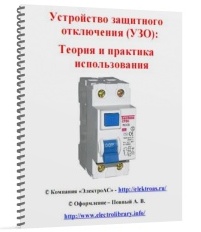Residual current device (RCD): Theory and practice of use

From the introduction to the book:
"Let's figure out what a protective shutdown device is, why it needs to be done, how to properly perform its wiring and check its serviceability (for the sake of brevity, we will refer to it as usual in the literature - RCD).
All RCDs are used for one important purpose - to protect a person from electric shock in the event of a malfunction of the electrical equipment and to shut off the power supply when unintentionally contacting the person with exposed conductive parts of electrical installations during a current leakage. It will protect the RCD and the ignition of the electrical wiring when it is shorted to the housing or to the ground.
In addition to the RCD, differential automata are also used for protection, which combine both a RCD and an automatic circuit breaker in their construction, which of course saves space for wiring in power and distribution panels, but can be much more expensive.
So - the RCD. What is this in terms of circuitry? In principle, it's just a quick-action switch. The principle of its operation is based on the response of the current sensor to the change in the differential current in the conductors, through which electricity is supplied to the electrical installation for which protection is organized. "
Book's contents:
Principle of operation of the residual current device (RCD)
Classification and types of residual current device (RCD)
What needs to be taken into account when wiring a residual current device (RCD)
Electric laboratory - measurements and tests of switches of automatic controlled by a differential current (RCD)
Why can not I install an RCD in the TN-C ground system?
Answers on questions
Uzo.pdf (in PDF )
Uzo.zip ( ZIP , 1,2 mb)


Comments
When commenting on, remember that the content and tone of your message can hurt the feelings of real people, show respect and tolerance to your interlocutors even if you do not share their opinion, your behavior in the conditions of freedom of expression and anonymity provided by the Internet, changes Not only virtual, but also the real world. All comments are hidden from the index, spam is controlled.